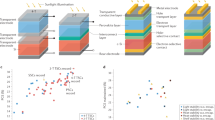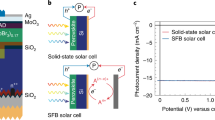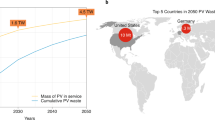Abstract
Tandem photovoltaic modules with silicon bottom cells offer a promising route to exceed the single-junction photovoltaic efficiency limit and further lower the levelized cost of solar electricity. However, it is unclear whether continued improvements in efficiency will render tandem modules cost-competitive with their two constituent sub-cells, and with silicon technology in particular. Here, we construct a simple and versatile techno-economic model that, for a given balance-of-systems scenario, calculates the tandem module efficiency and cost from assumed sub-cell module efficiencies and costs. To understand which input conditions are likely to be representative of the future photovoltaic market, we calculate learning rates for both module and area-related balance-of-system costs, and find that the slower learning rate of the latter means that high-efficiency tandems will become increasingly attractive. Further, in the residential market in 2020, the model indicates that top-cell modules could cost up to US$100 m–2—over twice that of the projected silicon module cost—and the associated tandem module would be cost-competitive if its energy yield, degradation rate, service life and financing terms are similar to those of silicon.
This is a preview of subscription content, access via your institution
Access options
Access Nature and 54 other Nature Portfolio journals
Get Nature+, our best-value online-access subscription
$29.99 / 30 days
cancel any time
Subscribe to this journal
Receive 12 digital issues and online access to articles
$119.00 per year
only $9.92 per issue
Buy this article
- Purchase on Springer Link
- Instant access to full article PDF
Prices may be subject to local taxes which are calculated during checkout




Similar content being viewed by others
References
Cole, W. J. et al. SunShot 2030 for Photovoltaics (PV): Envisioning a Low-cost PV Future (National Renewable Energy Laboratory, 2017); https://doi.org/10.2172/1392206
Fu, R., Feldman, D. J., Margolis, R. M., Woodhouse, M. A. & Ardani, K. B. US Solar Photovoltaic System Cost Benchmark: Q1 2017 (National Renewable Energy Laboratory, 2017); https://www.nrel.gov/docs/fy17osti/68925.pdf
Woodhouse, M. et al. On the Path to SunShot. The Role of Advancements in Solar Photovoltaic Efficiency, Reliability, and Costs Report No. NREL/TP--6A20-65872 United States10.2172/1253983 (National Renewable Energy Laboratory, 2016); https://www.nrel.gov/docs/fy16osti/65872.pdf
Ye, F. et al. in 2016 IEEE 43rd Photovoltaic Specialists Conference (IEEE, 2016); https://doi.org/10.1109/PVSC.2016.7750289
Green, M. A. et al. Solar cell efficiency tables (version 50). Progr. Photovolt. 25, 668–676 (2017).
Yoshikawa, K. et al. Silicon heterojunction solar cell with interdigitated back contacts for a photoconversion efficiency over 26%. Nat. Energy 2, 17032 (2017).
Yu, Z., Leilaeioun, M., & Holman, Z. Selecting tandem partners for silicon solar cells. Nat. Energy 1, 16137 (2016).
Grassman, T. J., Chmielewski, D. J., Carnevale, S. D., Carlin, J. A. & Ringel, S. A. GaAs0.75P0.25/Si dual-junction solar cells grown by MBE and MOCVD. IEEE J. Photovolt. 6, 326–331 (2016).
Cariou, R. et al. Monolithic two-terminal III-V//Si triple-junction solar cells with 30.2% efficiency under 1-Sun AM1.5g. IEEE J. Photovolt. 7, 367–373 (2017).
Essig, S. et al. Raising the one-sun conversion efficiency of III–V/Si solar cells to 32.8% for two junctions and 35.9% for three junctions. Nat. Energy 2, 17144 (2017).
Bush, K. A. et al. 23.6%-efficient monolithic perovskite/silicon tandem solar cells with improved stability. Nat. Energy 2, 17003 (2017).
Duong, T. et al. Rubidium multication perovskite with optimized bandgap for perovskite-silicon tandem with over 26% efficiency. Adv. Energy Mater. 7, 1700228 (2017).
Werner, J., Niesen, B. & Ballif, C. Perovskite/silicon tandem solar cells: marriage of convenience or true love story? – An overview. Adv. Mater. Interf. 5, 1700731 (2017).
Peters, I. M., Sofia, S., Mailoa, J. & Buonassisi, T. Techno-economic analysis of tandem photovoltaic systems. RSC Adv. 6, 66911–66923 (2016).
Bobela, D. C., Gedvilas, L., Woodhouse, M., Horowitz, K. A. W. & Basore, P. A. Economic competitiveness of III–V on silicon tandem one-sun photovoltaic solar modules in favorable future scenarios. Progr. Photovolt. 10.1002/pip.2808 25, 41–48 (2016).
A Snapshot of Global PV (1992–2016) (Photovoltaic Power Systems Programme, International Energy Agency, 2017); http://www.iea-pvps.org/fileadmin/dam/public/report/statistics/IEA-PVPS_-_A_Snapshot_of_Global_PV_-_1992-2016__1_.pdf
Photovoltaics Report (Fraunhofer ISE, 2017); https://www.ise.fraunhofer.de/en/publications/studies/photovoltaics-report.html
Wesoff, E. The End of Oerlikon’s Amorphous Silicon Solar Saga (GreenTechMedia, 2014); https://www.greentechmedia.com/articles/read/the-end-of-oerlikons-amorphous-silicon-solar-saga.
Wesoff, E. CPV Hopeful Soitec Latest Victim of the Economics of Silicon Photovoltaics (GreenTechMedia, 2014); https://www.greentechmedia.com/articles/read/cpv-hopeful-soitec-latest-victim-of-the-economics-of-silicon-photovoltaics
Stefancich, M., Chiesa, M. & Apostoleris, H. Do We Still Care About CPV? (International Society for Optics and Photonics, 2017); https://doi.org/10.1117/12.2273701.
Photovoltaic Manufacturer Capacity, Shipments, Price & Revenues (SPV Market Research, 2017); http://www.spvmarketresearch.com
Louwen, A., van Sark, W., Schropp, R. & Faaij, A. A cost roadmap for silicon heterojunction solar cells. Sol. Energ. Mat. Sol. C 147, 295–314 (2016).
International Technology Roadmap for Photovoltaic: Results 2016 (ITRPV, 2017); http://www.itrpv.net/Reports/Downloads/2017/
SolarServer. Global Solar Industry Website (accessed December 2016); https://www.solarserver.com
Solar Market Insight Report 2017 Q2 (Solar Energy Industries Association/GTM Research, 2017); https://www.seia.org/research-resources/solar-market-insight-report-2017-q2
Montgomery, D. C., Peck, E. A. & Vining, G. G. Introduction to Linear Regression Analysis 5th edn (Wiley, 2013).
McMeekin, D. P. et al. A mixed-cation lead mixed-halide perovskite absorber for tandem solar cells. Science 351, 151–155 (2016).
Todorov, T., Gunawan, O. & Guha, S. A road towards 25% efficiency and beyond: perovskite tandem solar cells. Mol. Syst. Des. Eng. 1, 370–376 (2016).
Warren, Emily L. et al. Maximizing tandem solar cell power extraction using a three-terminal design. Sustain. Energy Fuels 2, 1141–1147 (2018).
Liu, H., Aberle, A. G., Buonassisi, T., & Peters, I. M. On the methodology of energy yield assessment for one-Sun tandem solar cells. Sol. Energy 135, 598–604 (2016).
Mailoa, J. P. et al. Energy-yield prediction for II-VI-based thin-film tandem solar cells. Energy Environ. Sci. 9, 2644–2653 (2016).
Shen, H. et al. Mechanically-stacked perovskite/CIGS tandem solar cells with efficiency of 23.9% and reduced oxygen sensitivity. Energy Environ. Sci. 11, 394–406 (2018).
Eperon, G. E. et al. Perovskite-perovskite tandem photovoltaics with optimized band gaps. Science 354, 861–865 (2016).
Acknowledgements
We thank R. Fu (NREL), P. Mints (SPV Market Research), and C. Gay (DOE SETO) for discussions. The information, data and work presented herein were funded in part by the US Department of Energy, Office of Energy Efficiency and Renewable Energy, under Award Number DE–EE0006709, by the National Science Foundation under Award Number 1664669, and by the Engineering Research Center Program of the National Science Foundation and the Office of Energy Efficiency and Renewable Energy of the Department of Energy under NSF Cooperative Agreement Number EEC–1041895.
Author information
Authors and Affiliations
Contributions
Z.J.Y. developed the model, performed the analysis, and drafted the manuscript. J.V.C. assisted in data collection. Z.C.H. conceived the project idea and revised the manuscript. All authors approved the manuscript.
Corresponding authors
Ethics declarations
Competing interests
The authors declare no competing interests.
Additional information
Publisher’s note: Springer Nature remains neutral with regard to jurisdictional claims in published maps and institutional affiliations.
Supplementary information
Supplementary Information
Supplementary Figures 1–2, Supplementary Note 1, Supplementary References
Rights and permissions
About this article
Cite this article
Yu, Z.J., Carpenter, J.V. & Holman, Z.C. Techno-economic viability of silicon-based tandem photovoltaic modules in the United States. Nat Energy 3, 747–753 (2018). https://doi.org/10.1038/s41560-018-0201-5
Received:
Accepted:
Published:
Issue Date:
DOI: https://doi.org/10.1038/s41560-018-0201-5
This article is cited by
-
Stability challenges for the commercialization of perovskite–silicon tandem solar cells
Nature Reviews Materials (2023)
-
Device Engineering of Highly-Efficient Eco-Friendly Novel FASnI3 Based Tandem Photovoltaic Cells
Silicon (2023)
-
Comparative architecture in monolithic perovskite/silicon tandem solar cells
Science China Physics, Mechanics & Astronomy (2023)
-
Numerical Investigation of Perovskite and u-CIGS Based Tandem Solar Cells Using Silvaco TCAD Simulation
Silicon (2023)
-
Mix and match light absorbers
Nature Energy (2022)



